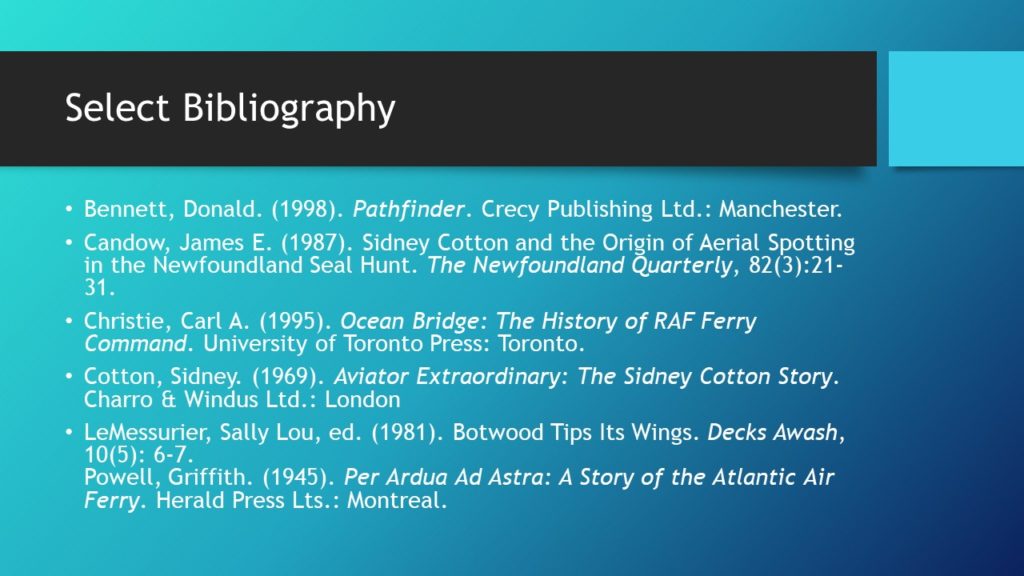This paper was first presented at the 2021 Aviation Cultures virtual conference based out of Australia (hence the theme of this paper). This conference is worth checking out, and throughout the year they have started having spotlight sessions on different parts of aviation history. I presented it again at Avalon Expo, and am now sharing it here. Added to this, I have an article in the current issue of NQ. The article is based on my Arts and Letters award winning article about Frances Grayson, The Dawn, and the mystery of the plane in the pond on the Cape Shore.
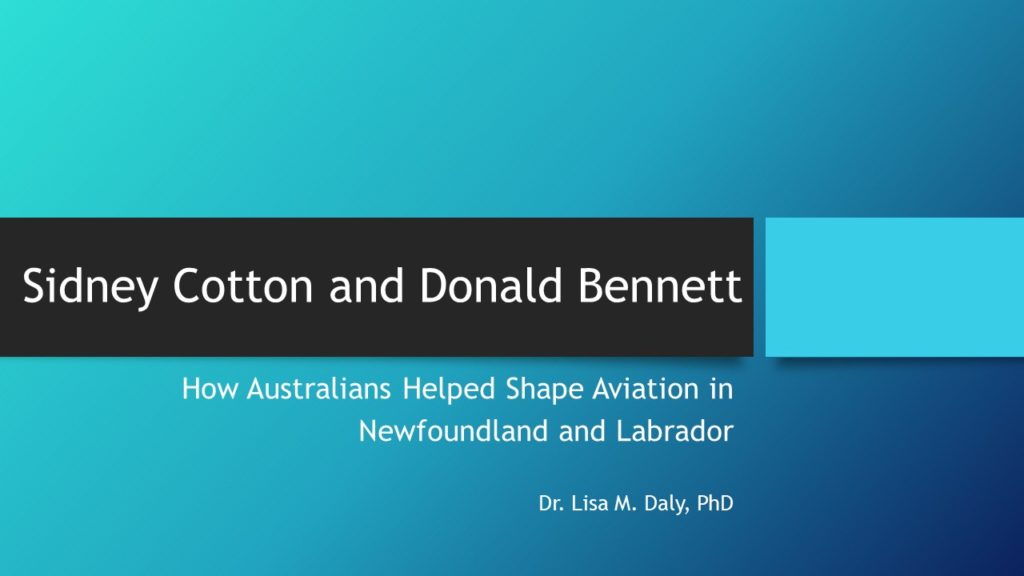
A little context, Newfoundland and Labrador became a Canadian province in 1949, prior to that, it was a British colony that held responsible government from 1832 to 1933. During the interim war years, the colony essentially went bankrupt (incredibly simplistic view, but it’s not the focus of this paper) and was run by a Commission Government until confederation. As for nomenclature, the official name of the province is Newfoundland and Labrador, but during the 1930s and 40s (the focus of this paper), it would have been referred to only as Newfoundland. Newfoundland is the island portion of the province, which is the most easterly point of land in Canada, and sticks out into the North Atlantic, and area where the Gulf Stream mixes with the Labrador Current to give unpredictable weather, strong winds, heavy fogs, rough seas, and iceberg alley. Countless aircraft and ships have been lost off the coast of Newfoundland. Labrador is the mainland portion of the province, connected to Canada. Labrador has a great deal of aviation history in its own right, but our focus will be on the island of Newfoundland.
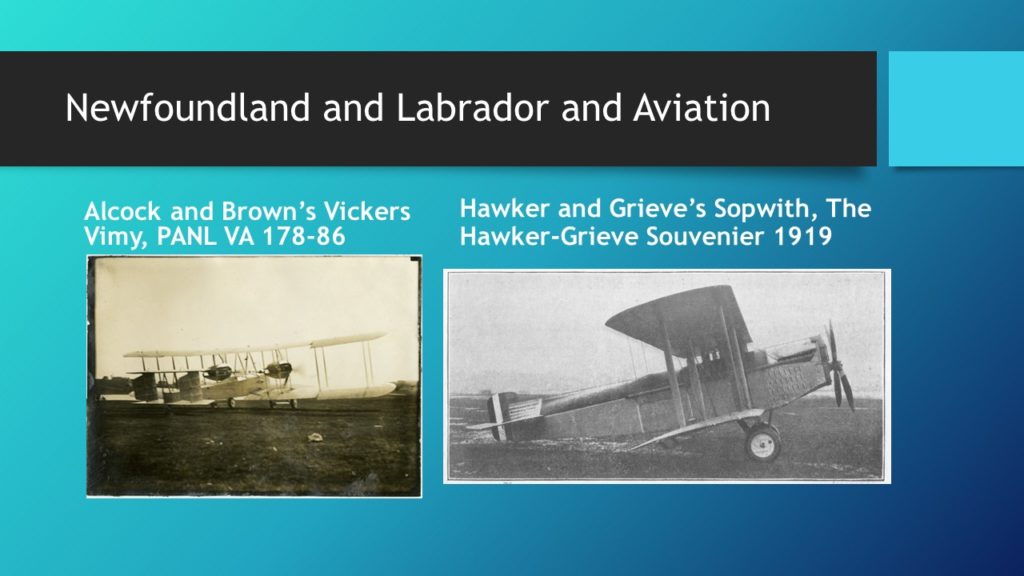
Due to its geographical location, Newfoundland has played an important role in aviation. In 1919, aviators used Newfoundland as a hopping off point in their attempt to cross the Atlantic. This was first accomplished by the United States Navy in their N-C flying boats which took multiple days to hop from Trepassey, Newfoundland, to the Azores, then on to Portugal. John Alcock and Arthur Whitten-Brown were the first to successfully fly non-stop across the Atlantic in their Vickers Vimy from St. John’s to Ireland. And, we do have an Australian connection here, as Australian Harry Hawker and Kenneth Mackenzie-Grieve took off from Mount Pearl, but ditched in the ocean. They were picked up by a ship with no radio, and were thought lost until the ship came close enough to land to signal that they were safe. They were given a hero’s welcome in England, and celebrated for their attempt.
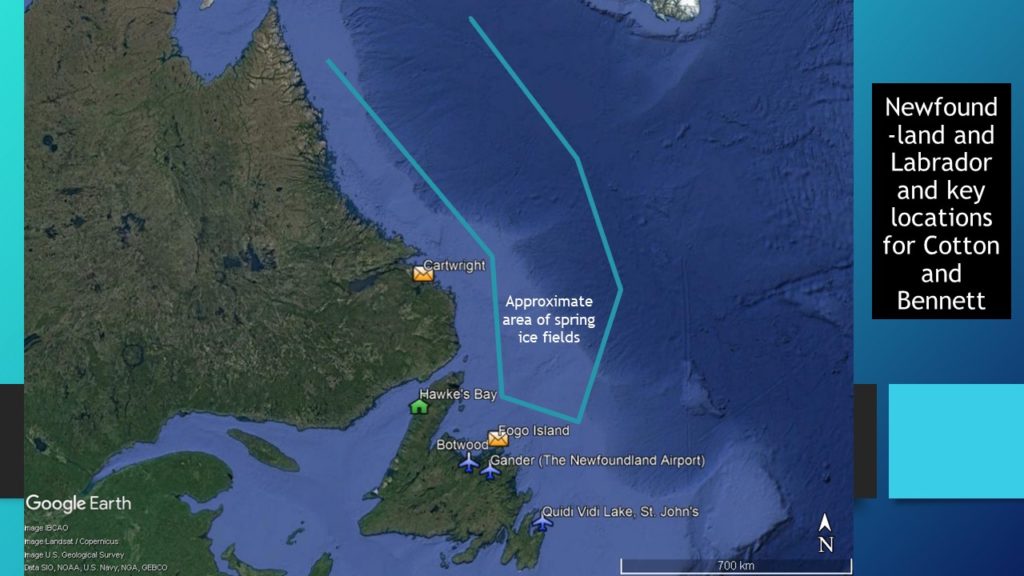
It was on the heels of the Transatlantic Air Race that Captain Sidney Cotton came to Newfoundland. Cotton was born on a cattle station in Queensland, Australia in 1894. In 1910, his father moved the family to England. Cotton became interested in aviation after Louis Bleriot’s cross channel flight. In 1912, the family returned to Australia but Cotton, against his father’s wishes, enlisted in the Royal Naval Air Service in 1915. He graduated the next year and took part in bombing operations over Germany. It was around then that he invented the Sidcot flying suit. After a disagreement with the head of RNAS operations, Cotton resigned his post and returned to Australia hoping to join the Australian Flying Corps, but the Admiralty prevented it. He left Australia and attempted to break flight records without much success.
When Cotton arrived in Newfoundland, he was told that the only flying suit worth wearing in the cold Newfoundland weather was the Sidcot. Cotton was in Newfoundland in 1920 after responding to an advertisement that had read “Pilot Wanted – Plenty of Risk, Good Pay”. The position was for a new venture where merchants in Newfoundland would pay for aerial seal spotting. Every spring, seals cluster on the ice floes of Northern Newfoundland, and swilers would sign up on sealing vessels who would hope to find the best sealing grounds. It could be a very risky venture, both due to the instability of the ice and the dangers of the seal hunt, but also the risk of not even finding the herds. But even with the great risk, swiling could be a very profitable business, and seal pelts and oil were expensive commodities.
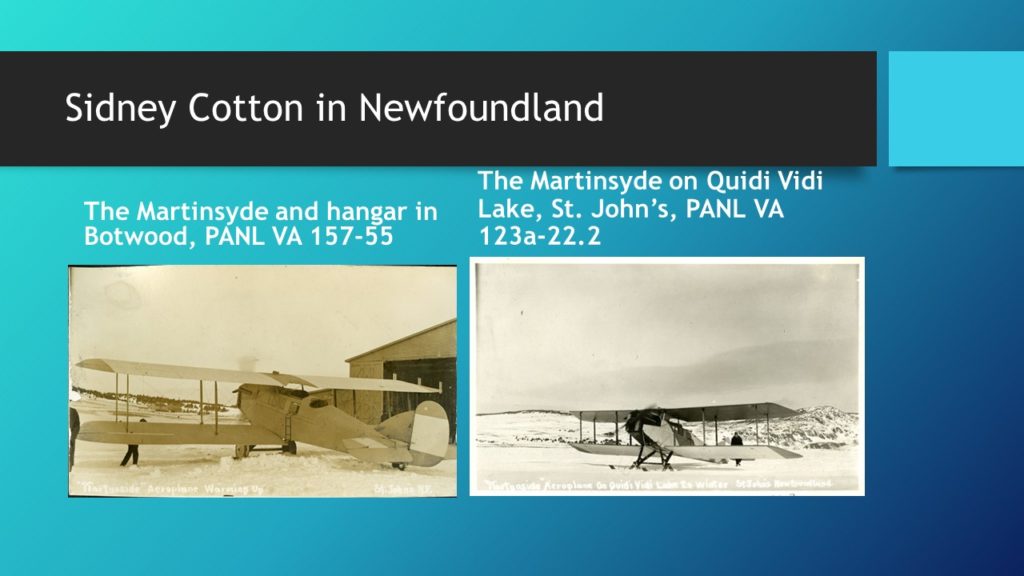
The idea was that this company run by Major Kenneth Edward Clayton-Kenney, formerly of the Aircraft Manufacturing Company, which had been supplied with two airships owned by the Newfoundland Government, would fly over the ice floes and direct the sealing ships to the herds via radio. The greatest risk would be that the flying would take place in early spring, which, in Newfoundland, is known for poor weather. Cotton was supposed to have supplied another aircraft for the contract, but just before leaving for Newfoundland, he wrote it off in a derby. Instead, he arrived with a Westland Limousine III aircraft and a salvaged DH 14A engine. He, a second pilot, Lieutenant David Plaistow of England, and two riggers/mechanics traveled from Liverpool to Newfoundland on the SS Digby, and when they arrived they were greeted by Captain Sydney Bennett, son of the Colonial Secretary to the Newfoundland Government, who would eventually work with Cotton.
Almost immediately, there were problems. Clayton-Kennedy was in financial difficulties. He had borrowed off the single payment he was to receive from the sealing companies, but the bank was looking for some of their overdraft back. Clayton-Kennedy tried to get a bigger payment from the merchants, but was unsuccessful. Cotton took over the contracts, and continued the efforts to set up a hangar in Botwood. Once Cotton had control of the contracts, he got rid of the airships, looking to focus solely on the use of amphibious aircraft. The plan was to have a hangar at Botwood, relatively near the ice fields. In January of 1921, work started on the hangar. Generally, little construction takes place in a Newfoundland winter, so digging into frozen earth, and waiting out snowstorms made building slow. Added to that, the supply line could often be cut, especially when blizzards blocked the rail lines, or, in some cases, when trains blew off the tracks. Early on, the fuel needed for the Westland was snowbound in St. John’s, and so he could not even test the aircraft after it was reassembled. When Cotton finally did get a test flight, a penny sized hold burnt through one of the pistons, so he had to cable to England to get a new piston sent. He was told the piston would take a fortnight to arrive, but the sealing ships would be setting off in three weeks. In the meantime, Cotton used a small aircraft with a Puma engine that he had acquired from Clayton-Kennedy and ran a few short, inland contracts, doing things like delivering mail to some of the islands in the area. Cotton did not feel that the aircraft was reliable enough for the open ocean to spot seals, but could be used to drop mail.
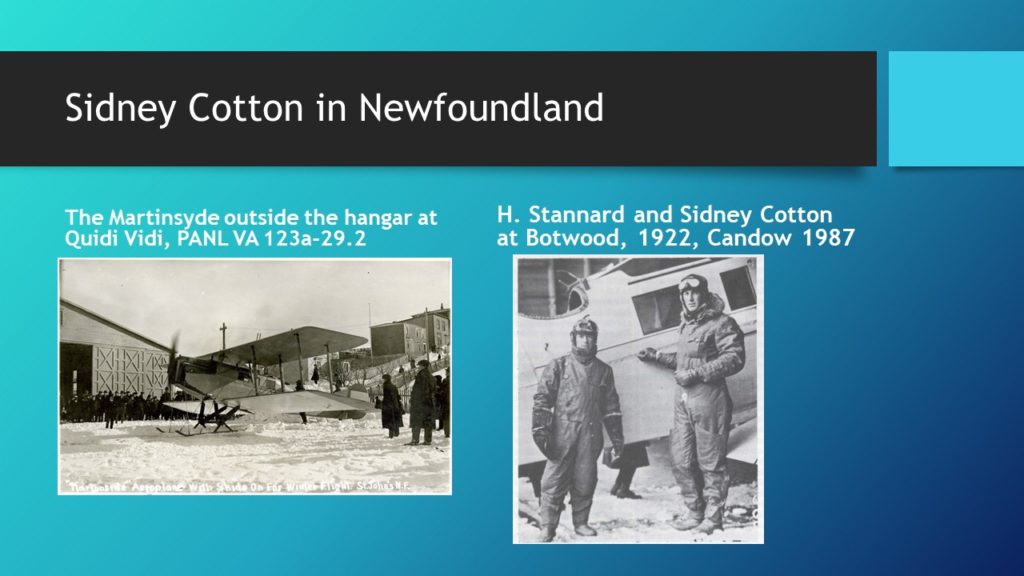
Just days before the sealing ships were due, Cotton managed to get the runways finished in Botwood, and the fuel and piston arrived. The piston was lighter than the others in the engine, but he had to use it to complete his contract. When the ships went out, Cotton too flew out to spot seals, but almost immediately his engine misfired. He flew back to the hangar and they found a tiny crack inside the carburettor intake. According to his biography, he “blanked off the water inlet to this carburettor and ran the engine with one carburettor hot and the other cold.” Not ideal, but the fleets were already at the ice fields and he had to get the plane in the air. He made a few local flights, then attempted a successful flight to Fogo Island and back. On March 29, 1921, Cotton finally set out for the ice floes, his very last chance to prove the benefit of seal spotting for that season as the ships were due back in St. John’s within days. He took off in the Westland early in the morning, with David Plaistowe as co-pilot, Heath as radio operator, and Captain Kean, a sealing captain to help identify and spot seals. They flew as far as Fogo and turned north to the ice fields when ice started flying past the cockpit. Hot water was leaking from a cracked water jacket and was freezing instantly. They had not yet spotted the fleet, so Cotton opted to turn back, not knowing how long they would have before the engine seized. They glided the last part of the way to Botwood, and when they landed, found the engine nearly dry. They quickly sealed the crack and tried again, but only made it about six miles beyond the bay before there was a metallic crash and the propeller stopped. Cotton had to glide and land on the ice, but then had to wait for Plaistowe to fly the DH 9 to find him and tow the aircraft back to the hangar.
Waiting for the next sealing season for what was supposed to ultimately be a lucrative contract, Cotton took on other work and secured more financing. Plaistowe left the operation and Sidney Bennet joined the team. Cotton also established a hangar at Quidi Vidi Lake in St. John’s to have a presence closer to the merchants and for mail pickup. He worked some mail routes, particularly from Botwood to Fogo and all of the little islands in between. Many winter mail runs were done by dogsled, and Cotton tried to argue that airmail would be faster, cheaper, and could use specialty stamps. He was not pleased to only get the one route, and was disappointed at the government insistence that some of the dog teams will remain employed, regardless of the extra cost. So, Cotton ran the Botwood to Fogo route on Tuesdays, with the entire run taking about two and a half hours. Once the success of that route was demonstrated, Cotton also received a St. John’s to Halifax, Nova Scotia route. Unfortunately, just as he was to start the route, using a Martinsyde they had acquired for the job, one of the aircraft’s skis went through the ice and twisted the undercarriage. Instead, Cotton used the DH 9, which only made it as far as Deer Lake before water started seeing from the cylinder head of the engine. Cotton and Bennett landed, and during repairs, Cotton was pinned under the aircraft and ended up being put on the train and sent to the hospital in St. John’s. For several weeks, Cotton was laid up, but took advantage of his time in St. John’s to try to secure new contracts with the sealing companies, as well as trying to establish some form of insurance for his aircraft and companies were refusing to cover winter flying in Newfoundland.

Cotton did not have an agreement with the sealing companies like Clayton-Kennedy had. After the failure of the previous season, the merchants did not want to promise money on something that was not guaranteed. Cotton was confident in his ability, especially with the fact that he had secured two Martinsydes for the task, and he believed they were much better suited than the DH 9. As well, using the same technology he had used in designing the Sidcot, Cotton designed an engine cover to fit tightly around the nose of the plane and cover the engine compartment completely while leaving the propellers free. He also installed catalytic lamps at the base of the engine to prevent it from getting cold. Cotton was confident that in cold weather, the covers could be removed just before flight and refitting immediately after landing to keep the engine warm. He also, with the help of an unnamed local, added alcohol to the water in the radiators. Untreated alcohol would evaporate, but a local advised him to boil the alcohol in a wooden barrel three time as then the alcohol would not evaporate. The system seemed to work.
Cotton was also a showman, which didn’t help secure the contracts. He learned that one of the directors for Job Brothers needed to come back to St. John’s immediately, so, to show the capabilities of his aircraft, Cotton took off from Quidi Vidi, flew to Murray’s Pond Country Club where Mr. Brooks was skiing, landed at the pond near the skiers, picked them up and brought Mr. Brooks back to St. John’s. But it still did not convince the merchants. Continuing with his dramatic means to court the sealing merchants, when the ships went out to the ice floes that year, Cotton had no seal spotting contract, but delivered mail to the vessels. He took the Martynside, flew around the foes a little until he spotted a herd, landed next to the Sagona, delivered the mail and discussed the location of the seals before flying back to Fogo. The ships seemed to appreciate the help, and reported back to the merchants, but Cotton could still not get any further with companies. At this point, Cotton decided that the only way he would get a contract would be if the sealers became desperate, so, rather than deliver mail to the vessels and give free seal spotting, Cotton took a mail contract to fly mail to Labrador, a contract which would take several days to complete. When Cotton arrived back in St. John’s, he learned that the sealing vessels had been having little luck, so, with about a week left to the season, he flew the Martinsyde to the sealing vessels, located a herd, and noted how the ice was flowing and the best route for the ships to take to get to the seals. He flew back to St. John’s and informed the merchants that he had found the herd, but they still refused to offer a contract. The companies wanted to confirm the location of the seals before agreeing to anything, saying they wouldn’t use the information until after a contract was settled. Cotton decided to give them the location of the seals, plus detailed how the ice was flowing and the best route. The merchants, gave the location of the seals to their ships, but not the ice warning as no one could remember the ice ever behaving in that manner so they did not actually trust Cotton’s information. The ships attempted a direct route to the seals, and became jammed in the ice. The herd was never located, the sealing season was a failure, but Cotton was paid $2,000 for his work. He still wanted a more lucrative contract.

With the sealing season over, Cotton established Hawkes Bay Trading Company, later Aerial Survey and Communications when he and his business partner split. Cotton did work delivering mail, and went through The Daily Mail‘s Lord Northcliff, who owned the Northcliffe Papermills in Grand Falls, to gain a survey contract to find logging areas. Cotton worked on aerial photography and overlapping photographs to create complete aerial pictures. He also did some survey work in Labrador, surveying the gold fields. Cotton also pushed for more mail contracts, but was not as successful gaining them as he would have liked. He did get a break with the seal contracts. The companies still were not keen on signing on his long-range seal spotting, but proposed that the merchants buy a small Avro left from Shackleton’s last expedition. The aircraft could be stored on a ship, dropped over the side, and used for short survey hops. The Newfoundland Government offered to pay for half the aircraft, and Cotton the other half, and he would be paid to operate it. He agreed and brought in a pilot for the Avro, but the ice conditions were wrong for its use. That spring, Cotton was flying over the ice floes in the Martinsyde, 200 miles from land, when he had engine troubles and suddenly realized the risks involved in seal spotting and decided to give up the venture. By August 1923, Cotton had everything that couldn’t be transported sold, except for his two hangars, and had packed up and left Newfoundland.
This wasn’t exactly the end of his affiliation in Newfoundland. He went on to marry Joan Henry from Hawkes Bay, and returned to Newfoundland 1927 to work on other projects. While there, L’Oiseau Blanc went missing while attempting to win the Orteig Prize, and Cotton was approached to search around Newfoundland for the aircraft. He acquired a Fokker monoplane, and, accompanied by a reporter, searched for the aircraft based on possible sightings around Newfoundland and Labrador. He searched about 15,000 square miles, but found no evidence of the missing aviators.
Jumping forward a few years, Cotton is doing mapping and survey work helping England in the war effort. Back in Newfoundland, an airfield was in the process of being constructed. Originally built to shorten mail times overseas, the war turned the Newfoundland Airport into one of the largest airbases in the world. Before the airport was complete, Lord Beaverbrook in England developed a plan to fly aircraft overseas. At the start of the Second World War, aircraft were built in North America, disassembled and crated, shipped across U-Boat infested waters, and those that did arrive, then had to be reassembled and tested before they could enter the war effort. The first test of the possibility to deliver aircraft by air was seven Hudsons. Beaverbook had decided that of the seven aircraft, if three made it, the project would be deemed feasible and air delivery would continue.
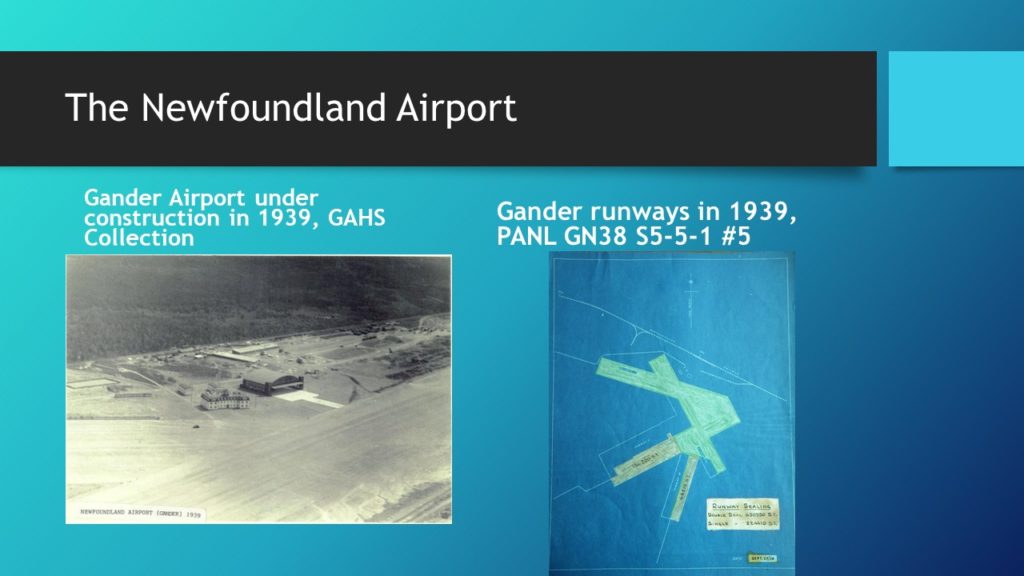
Donald Bennett was born in Toowoomba, Queensland, in 1910, son of a grazer and business agent. He joined the RAAF in 1930, qualifying as a pilot at RAAF Point Cook. The following year, he transferred to the RAF and the 210 Squadron flying boats, then as an instructor. In 1935, he left the RAF to join Imperial Airways, specializing in long distance flights and setting flight records. Bennett was brought into what would be called the Atlantic Ferrying Organization, or ATFERO, and put in charge of making the necessary preparations for the initial flight of the Hudsons. Bennett worked closely with Lockheed to prepare the aircraft, install more fuel tanks, and even getting them to allow him to conduct test flights to determine the capabilities of Hudsons being able to fly the North Atlantic. When the aircraft were due for Newfoundland, Bennett hitched a ride. He wasn’t allowed to fly the aircraft out of the states, due to treaties and American neutrality laws. In fact, the aircraft could not be flown to Canada or Newfoundland at all. They were flown to the border near Dorval, Quebec, and horses were used to bring the aircraft over the border where they could be flown from Dorval to the Newfoundland Airport. Bennett stayed in Dorval to help train the new pilots, and content with the ever present politics of ATFERO. Some of the pilots were RAF, while many others were hired from the United States. Generally, the American pilots were crop dusters and barn stormers, and were paid considerably more than the RAF flyers. After a few weeks of training, the Hudsons were flown in formation from Dorval to Gander. There were not adequate navigators, so navigation would rely on staying in formation and following the leader. Thankfully, a few experienced British Overseas Airways and Imperial Airways pilots with more experience than many of the new hires, joined the crew. In early November, 1940, Bennett was finally in Newfoundland to prepare for the transatlantic attempt. He assumed it would be a quick layover in Gander, but the arrival of the aircraft had been staggered, and by the time he reached the airfield on November 9th, there had been snow and frost, so the aircraft had to be chipped out of the built up ice. The aircraft were ready to go the following day, and received a weather forecast from McTaggert-Cowan, the meteorological officer for Gander who was based at the float plane base in Botwood (this was later transferred to Gander). The forecast relied on limited ocean information, so wasn’t perfect, but was more than adequate for the flight preparations. Just before the seven Hudsons left Gander, Mrs. Patterson, the wife of the airport manager, distributed poppies to the crew as when they landed it would be Armistice Day. The seven aircraft took off from Gander just after sunset one at a time, and each aircraft would join the formation that circled the airport. Once all were air born, they took off across the Atlantic. The aircraft were equipped with radios, but were supposed to maintain radio silence for the flight. Bennett was in the lead aircraft, and once they were in formation, he gave the control to his co-pilot and became the navigator for the whole of the seven aircraft. It was also as he handed over controls, that he noticed that his co-pilot, who was from Texas, was wearing cowboy boots for good luck! Not surprising for over the Atlantic, but the aircraft encountered a heavy fog bank that they could not go over, so had to go through, each aircraft following the lights of those ahead of them. At one point, one aircraft did break radio silence, and any chatter was quickly shut down by the radio operator in the lead aircraft. Close to Ireland, Bennett descended out of the clouds and landed at Aldergrove. Soon after, five of the seven aircraft had landed. The sixth arrived a little while later. The crew of that aircraft had misread their map and had flown toward Scotland before finding their bearings. The seventh aircraft had landed at the wrong aerodrome, but had successfully made the crossing.
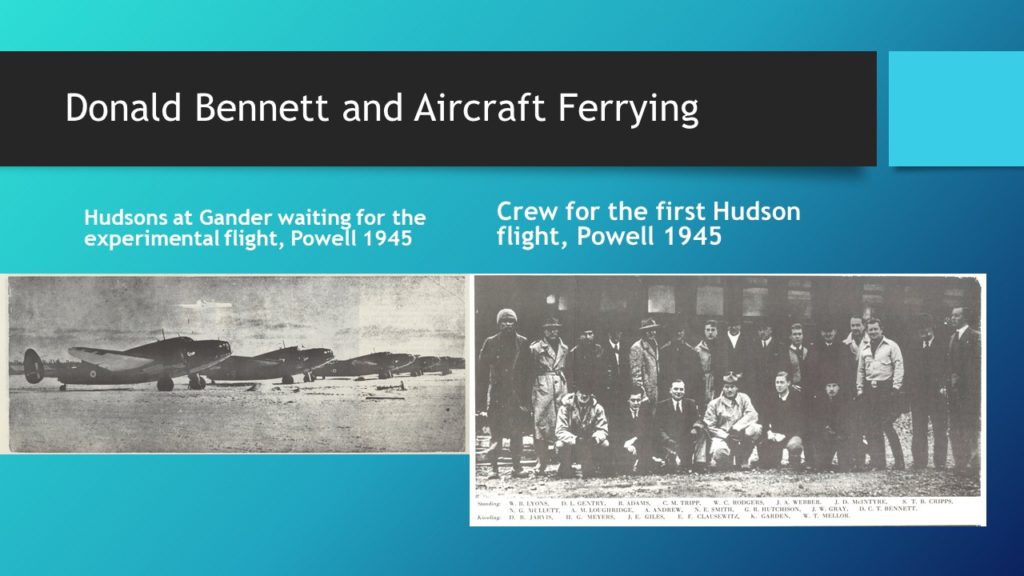
From Beaverbrook’s plan that ATFERO would proceed if only three of the seven Hudsons made the flight, Bennett ensured that all seven made it.
While this is the more dramatic part of Bennett’s role in ATFERO, he continued to make sure the pilots were well-trained and the aircraft well-prepared for the journey. ATFERO was granted pilots, and those pilots would make multiple ferry runs. Navigators, on the other hand, would be ferried across once to join the war effort, so while the pilots gained more and more experience ferrying, the navigators were often newly trained and would only cross the Atlantic once.
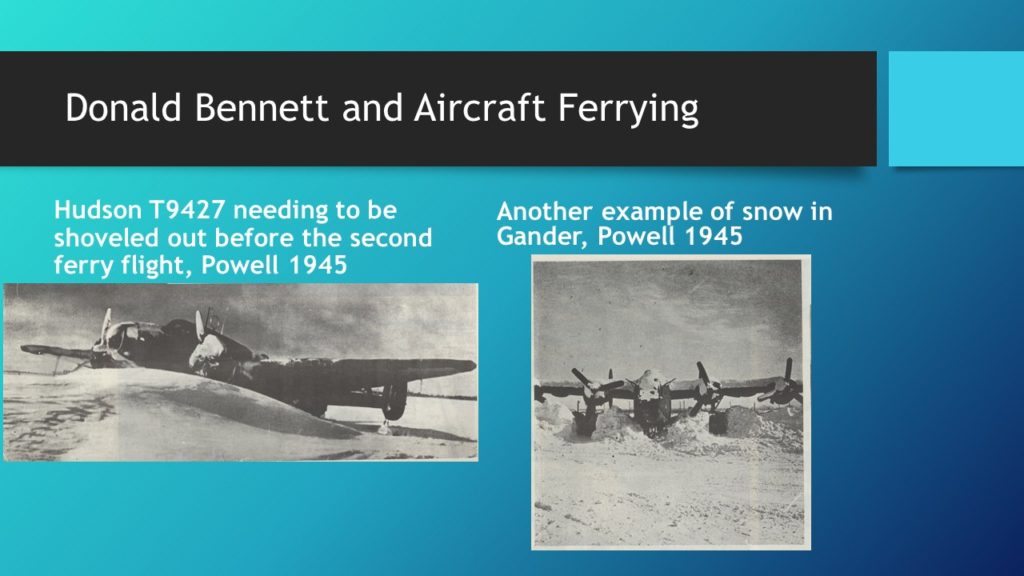
While Bennett did all he could to ensure safety, there were incidents. While Bennett was in San Diago to test the new B-24s, Sir Frederick Banting, the co-inventor of insulin, used his connections to secure a flight on a Hudson going overseas. He would be cargo, simply transported closer to the war front where he thought his role as a scientist could be more beneficial. On February 20th, 1941, the aircraft carrying Banting went missing after takeoff, a first for ATFERO. Bennett hurried back, but first, he called the pilot’s wife. Bennett believed that wives often knew if something had happened to their spouses, and, throughout his career, would often call wives if husbands were missing. Mrs Mackey said her husband was alive, and Bennett treated as a search and rescue. When the aircraft was found, Mackey was indeed alive, but was the only one. The radio operator and navigator had not even managed to bail out and died in the crash. Banting was seriously injured and died the following day. There is a great deal more to this story, and I wrote about it in a chapter in Canadians and War Vol. III by Lammi Publishing, for those interested. After eleven month of operation, this was the first major incident and the first fatalities associated with AFTERO.

At the start of ATFERO, the pilots would fly across then would take a boat back, but as Very Long Range Bombers were being shipped, B-24s were used to fly back a number of pilots at a time, reducing the wait time between flights across. Bennett flew the first return flight, with the pilots sitting in the bomb bay on mattresses just trying to stay warm. In his memoir, Bennett believes he was the first to fly non-stop from the UK to Montreal with a land plane on May 8th, 1941. He had made the trip in a float plane, and had been the first to do so, in 1938.
Bennett also started to have some of his control taken away during multiple reorganizations of the program. First, much of his power was removed when a bush pilot, with no long range, airline, or transatlantic experience was put in charge of the program. Later, during another reorganization, many people in high political positions wanted part of the success of ATFERO, and it was decided that ATFERO would cut ties with Canadian Pacific Railway, who had been instrumental in transportation. Within months of that reorganization, AFTERO came under the purview of the RAF, and Bennett left Ferry Command for other roles during the war.
In the six weeks after he left, there were a number of changes beyond the name from Atlantic Ferrying Organization to RAF Ferry Command. The first was a return flight leaving from Prestwick that failed to clear a mountain, killing all on board. Another, was due to the aircraft being overweight. The RAF had increased the allowable weight for B-24s and this one did not get off the runway. Another pilot was misidentified on approach and given poor instructions, and six Hudsons were lost between Canada and the UK. In his memoir, Bennett believes that many of those incidents would not have happened under his supervision. Bennett went on to lead Pathfinder missions, but left a lasting mark on transatlantic aviation.
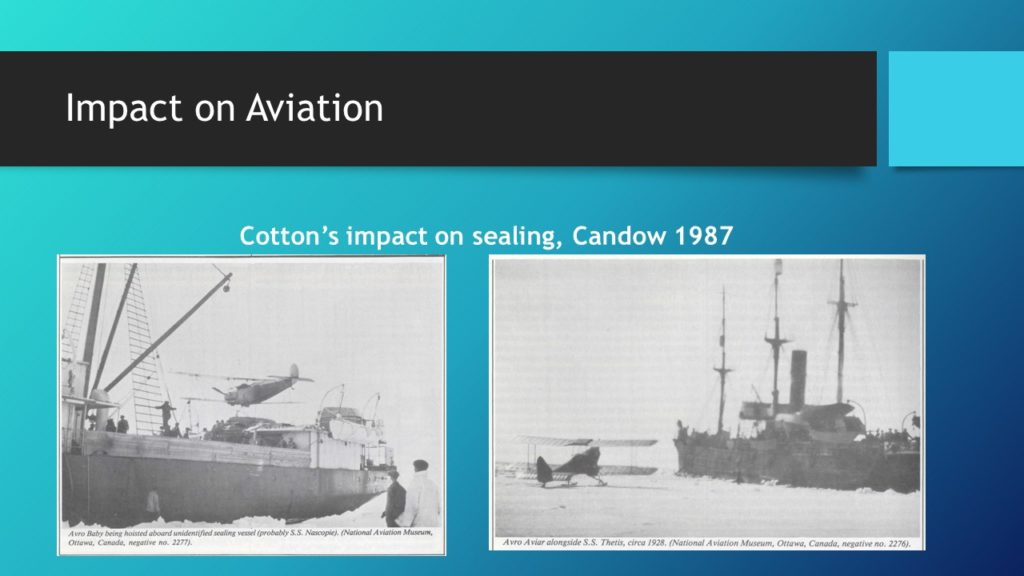
Sidney Cotton and Donald Bennett each impacted aviation in Newfoundland by determining the extent to which aviation could be used in Newfoundland and Labrador. Cotton showed that cold weather flying was a challenge, but possible, and the Avro Baby was used for years after Cotton left. His early innovation in fuel mixing to prevent lines from freezing was a pivotal act that allowed for the possibility of more flight in colder regions. Prior to this, it was generally believed that severe winter weather and cold temperatures would keep aircraft grounded. With the establishment of local commercial aviation companies in the 1960s in Newfoundland and Labrador, airlines would take aircraft out to spot seals and fish and radioing their location to boats became a much more common practice. A bit later, aircraft were not just used for seal spotting, but for a couple of years float planes out onto the ice flows transporting hunters to the seals and transporting back the carcasses to the camp on the same day. This practice was dangerous as spring ice unpredictable and there were fatalities that stopped the practice.
Delivering mail and supplies to isolated communities, in particular those that can be inaccessible in the winter months is still a common practice in Newfoundland and Labrador. Often, in hard winters when the ferries cannot run, helicopters are still used to transport supplies if the ice lasts too long, and people who need to travel for medical emergencies. Islands like Fogo and Change Islands can still get iced in, and the Strait of Bell Isle can also ice over, preventing transportation between Newfoundland and Labrador. Cotton’s legacy is that he demonstrated how aviation could help those isolated areas be better connected and how aviation could help in a crisis.
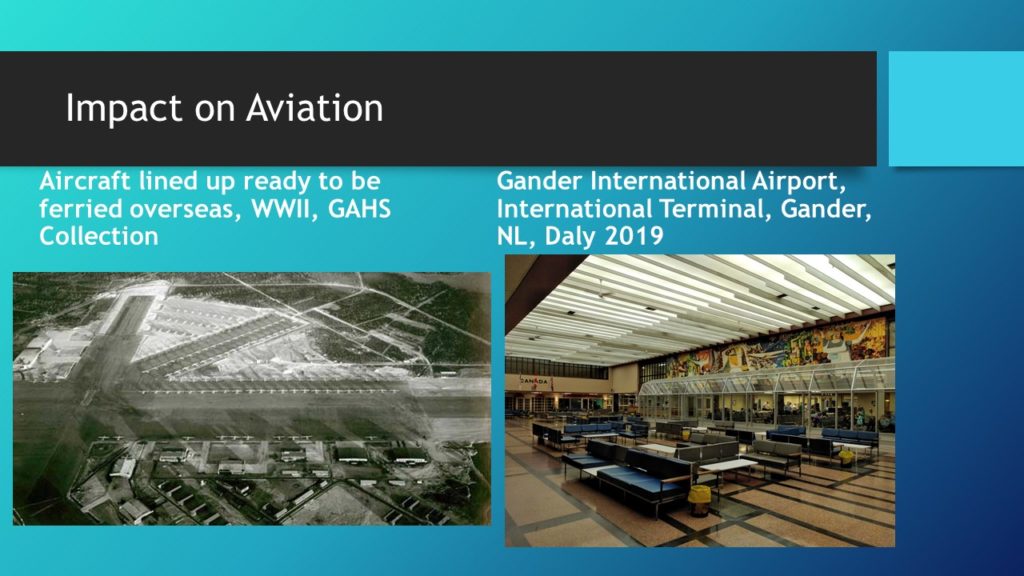
Bennett solidified Newfoundland and Labrador’s role in trans-Atlantic aviation. Of course, Newfoundland’s geographic location is pivotal, but Bennett pushed aircraft to their known limits at the time to really demonstrate the ability for transatlantic travel. Before the war was even over, the Commission of Government in Newfoundland was negotiating commercial aviation contracts that would use Gander as the last refueling point, and while transatlantic flights were possible, they were not always successful. During the 1920s and 30s, numerous aircraft had tried and failed to make the crossing, most recently in Newfoundland history had been the Lady Peace in 1936 which had attempted to make a round-trip transatlantic flight, and ended up crashing in Musgrave Harbour, Newfoundland, while trying to reach the airfield in Harbour Grace. Bennett’s preparations showed that with training, experience, and care for the aircraft, crossings were possible, and not only that, possible at any time of the year. Prior to Bennett’s work, winter and even early spring crossings were generally seen as dangerous and those that were attempted were often lost. Bennett opened up the skies of the North Atlantic to be flown any time of year. Of course, there were accidents. There were numerous over the course of the war, and not just Ferry Command. The RAF, RCAF, and USAAF, and used the airport at Gander and all had incidents that involved the loss of aircraft and of crew. Numerous aircraft were lost over the Atlantic, their reason for not making their destination lost with them. Even after the war, early commercial aviation had risks. In 1946, there were two accidents that made headlines around the world as the Sabena DC-3 crashed near Gander in September and was the most tragic commercial crash with 26 fatalities, and was the first helicopter rescue on the island of Newfoundland, then two weeks later, an American Overseas Airlines aircraft crashed in Stephenville, killing all 39 on board. But these incidents, while tragic, were among the thousands of aircraft that successfully made the flight, establishing the potential for regular transatlantic aviation.
Incidents and fatalities aside, both Cotton and Bennett were key players in opening the airways in Newfoundland. While Cotton’s work was much more local, his improvements to winterize aircraft paved the way for further improvements that allowed Bennett to successfully and regularly fly bombers across the ocean. Both of these Australians played important roles in the establishment of Newfoundland, by virtue of the island’s geography, as a hopping off point and refueling point for transatlantic aviation. In fact, Gander had the title of the Crossroads of the World until the 1980s when the jet age improved to such a point that aircraft didn’t need to refuel after crossing the ocean. Both men are well-known figures in Newfoundland and Labrador aviation history.
